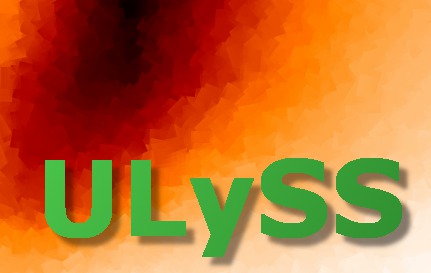
|

|
;+ ; NAME: ULY_LSF ; ; PURPOSE: Determine the line-spread function (LSF) ; ; USAGE: uly_lsf, <spectrum>, <cmp>, <width>, <step>, $ ; FILE_OUT=file_out, /PLOT, /QUIET, /CLEAN, $ ; KMOMENT=<kmoment>, DG=<dg>, DL=<dl>, $ ; KFIX=<kfix>, KPEN=<kpen>, $ ; MDEGREE=<mdegree>, ADEGREE=<adegree>, $ ; VELSCALE=<velscale> ; ; ARGUMENTS: ; <spectrum> Filename or spectrum structure containing the spectrum ; to be analysed for the LSF. ; <cmp> Component structure containing the reference high ; resolution spectrum. The LSF of <spectrum> will be ; determined relatively to <cmp> ; In the simplest case, <cmp> can be a reference spectrum ; loaded with ULY_STAR, or it can be an interpolated ; stellar model (see ULY_TGM) or any other model, or even ; an array of several cmp. ; During the analysis, eventual non-linear parameters ; will be adjusted. ; <width>, <step> scalars, [Angstrom] ; The LSF is measured in a succession of chunks of width ; <width> separated by <step>. ; ; KEYWORDS: ; FILE_OUT Name of the output file. ; Defaulted to 'output.lsf' ; KMOMENT, DG, DL, KFIX, KPEN ; LOSVD parameters passed to ULySS. ; They are used to determine which terms of the LSF to fit. ; MDEGREE, ADEGREE, VELSCALE ; Parameters passed to ULySS. ; Remember that MDEGREE (and ADEGREE) apply to the (small) ; chunks of spectra of width <width>, so, this parameters ; should be smaller than when the whole spectrum is ; analysed at once. ; PLOT Set this keyword if you want to display the ; losvd fit using the program ULY_SOLUT_SPLOT. ; CLEAN ; Set this keyword to perform a kappa-sigma clipping ; of the outliers. ; QUIET Verbosity control ; ; EXAMPLE: ; In the following example, we determine the relative LSF between a ; spectrum to analyse and a model extracted from a grid. ; Then we smooth this LSF and use it to analyse the spectrum. ; ; filetest = uly_root+'/data/VazMiles_z-0.40t07.94.fits.fits' ; model = uly_ssp_extr(filetest, uly_root+'/models/PHR_Elodie31.fits' ,[6000.,-0.4,0.], SIG=30) ; cmp = uly_star(model) ; uly_lsf, filetest, cmp, 200, 100, FIL='vaz.lsf', /QUIET ; heap_free, cmp ; uly_lsf_plot, 'vaz.lsf' ; uly_lsf_smooth, 'vaz.lsf', 'vazs.lsf' ; uly_lsf_plot, 'vazs.lsf' ; cmp = uly_ssp(LSF='vazs.lsf') ; ulyss, filetest, cmp, /PLOT ; ; LSF ANALYSIS AND INJECTION: ; ; A spectrum is characterized by its line spread function, LSF, ie. the ; instrumental broadening of the spectral lines. This is the analog of the ; PSF for images. The LSF can be modeled by a Gaussian or more generally ; by a Gauss-Hermite expansion of a Gaussian. ; ; For an observation, the LSF depends on the spectrograph and on the slit, ; it generally changes with the wavelength and, in the case of 2 or 3D ; spectra, with the position in the field. On the other side, the model ; used to analyse this observation has also a finite resolution, i.e. ; has a specific LSF hopefully finer than the one of the observation. ; Therefore to analyse an observation we have to take into account the ; relative LSF of the observation with respect to the model. This is of ; a primordial importance when studying the internal kinematics (physical ; broadening of the lines) of an astronomical source. ; ; The process to properly take the LSF into consideration consists in ; two phases: (i) The determination of the relative LSF and (ii) its ; injection into the model, so that the result is comparable to an ; observed spectrum. ; ; Choice of the LSF standard ; ; In standard cases, the LSF can be considered as stable for a set of ; observations, for example for an observing run, or for a given setup of ; an instrument. In this case it is possible to determine it once using ; the calibration and standard stars observations. There are ; different ways to determine the LSF. ; ; 1) Using the arc spectrum used for the wavelength calibration. ; The profile of the lines can be determined at different wavelength ; and position in the field (sigma, h3, h4). ; This method is currently not implemented in ULySS and requires ; some precaution because of blends of the lines and limited sampling. ; ; 2) Using a twilight spectrum, and compare it with the solar spectrum ; having the same LSF as the model. The input aperture is uniformly ; illuminated. This is the preferred method. ; ; 3) Using a spectrum from a star for which a spectrum with the same LSF ; as the model is available. The critical aspect of this method is ; to be sure that the stellar light is uniformly distributed over ; then entrance aperture or that the resultion is not determined by ; the size and shape of the entrance aperture. ; ; 4) Using a spectrum of a star of known atmospheric parameter, ; and analyse it with the output of a library interpolator. Or use a ; spectrum of a star with unknown atmospheric parameters and determine ; first these parameters with ULySS (see ULY_TGM). ; ; Finally, if no stellar spectrum is available, the analysis can be done ; with an observation of a galaxy and the internal kinematics of all ; objects in the series will be determined relatively to this reference. ; (choose the galaxy with the smallest velocity dispersion or decrease ; the width of the measured LSF by a fixed amount (use the keyword SIGMA). ; ; Caveat: To maximize the flux efficiency, some setups use a wide input ; aperture (slit) that may be eventually wider than the seeing and that ; the intrinsic resolution of the spectrograph. The result is that in ; case of good seeing the object may be resolved in the slit, and the ; measured broadening does not reflect the physical broadening. This is ; a poor practice, and such observations should not be used to study ; the internal kinematics. ; ; Analysis of the LSF ; ; The analysis of the LSF is made with the program: ULY_LSF ; which produce an ASCII file describing the LSF (see the ; Description section in this article). ; This file may be viewed with ULY_LSF_PLOT, or smoothed with ULY_LSF_SMOOTH. ; ; Injection of the LSF ; ; The LSF injection is made by: ULY_SPECT_LSFCONVOL, normally called when ; a component of the model is initialized or evaluated. ; The principle of the injection of the LSF in the model is briefly ; introduced in Koleva et al. 2008. ; ; HISTORY: ; Mina Koleva, 2008/03/11, created ; Yue WU, 2009/03/05, updated ; Philippe Prugniel, 2015/08/10, updated ; ;- ; CATEGORY: ULY ;------------------------------------------------------------------------------ pro uly_lsf, spectrum, cmp, width, step, $ FILE_OUT=file_out, PLOT=plot, CLEAN=clean, $ KMOMENT=kmoment, DG=dg, DL=dl, KFIX=kfix, KPEN=kpen, $ MDEGREE=mdegree, ADEGREE=adegree, VELSCALE=velscale, $ QUIET=quiet if n_elements(spectrum) eq 0 or n_elements(cmp) eq 0 or $ n_elements(width) eq 0 or n_elements(step) eq 0 then $ message, 'Usage: ULY_LSF, <spectrum>, <cmp>, <width>, <step>, [optional keyw]' if n_elements(file_out) ne 1 then lsf_file = 'output.lsf' $ else lsf_file = file_out ; ---------------------------------------------------------------------------- ; Read the observed spectrum from which to determine the LSF if uly_spect_get(spectrum, /VALID) eq 1 then begin SignalLog = uly_spect_alloc(SPECT=spectrum) endif else begin SignalLog = uly_spect_read (spectrum, QUIET=quiet) endelse if size(*SignalLog.data, /N_DIM) gt 1 then $ message, /INFO, 'The file array to process has ' + $ strtrim(size(*SignalLog.data, /N_DIM),2) + ' dimensions ... we use only the first spectrum' SignalLog = uly_spect_extract(SignalLog, ONED=0, STATUS=status, /OVER) if status ne 0 then message, 'Could not extract 1D spectrum' SignalLog = uly_spect_logrebin(SignalLog, velscale, /OVER) possig = where((*SignalLog.data) gt 0, cnt) if cnt eq 0 then $ message, /INFO, 'The signal is everywhere null or negative in the spectrum to analyse' velscale = SignalLog.step * 299792.458d wr = uly_spect_get(SignalLog, /WAVERANGE) ; ---------------------------------------------------------------------------- ; Read the LSF reference cmp (used as an LSF standard) status = uly_fit_init(cmp, WAVERANGE=wr, VELSCALE=velscale, QUIET=quiet) if status ne 0 then begin message, 'Fit initialization failed, abort', /CONT return endif model_range = exp(cmp[0].start + [0.5,cmp[0].npix-1.5] * cmp[0].step) ; re-cut the input spectrum to the range of the model SignalLog = uly_spect_extract(SignalLog, WAVERANGE=model_range, /OVER) wr = uly_spect_get(SignalLog, /WAVERANGE) ; ---------------------------------------------------------------------------- npix = n_elements(*SignalLog.data) lamrange = wr nlsf = floor((lamrange[1]-lamrange[0]-width)/step) + 1 ;loadct, 2, /SILENT if file_test(lsf_file) then file_delete, lsf_file ;openw, lun, lsf_file, BUFSIZE=0, /GET_LUN ;printf, lun, '# lsf_format=1', FORMAT='(a)' ;printf, lun, '# chi2, cz[km/s], e_cz, sigma[km/s], e_sigma, h3, e_h3, h4, e_h4, wl_c[Angstroms], Wstart, Wend', FORMAT='(a)' undefine, sol_lsf for nn = 0, nlsf-1 do begin minWL = lamrange[0]+step*nn maxWL = min([minWL+width, lamrange[1]]) ; centrWL= fix((maxWL-minWL)/2.+minWL) s = uly_spect_extract(SignalLog, WAVERANGE=[minWL,maxWL]) if not keyword_set(quiet) then print, 'LSF chunk: ', nn ulyss, s, cmp, $ KMOMENT=kmoment, DG=dg, DL=dl, KFIX=kfix, KPEN=kpen, $ MDEGREE=mdegree, ADEGREE=adegree, QUIET=quiet, PLOT=plot, CLEAN=clean, SOL=sol uly_spect_free, s ; write the results in the output file if size(sol,/TYPE) ne 8 then begin ; we have a pb there ... we expect a fixed set of wavelengths for each ; LSF, it is in particular important when we measure a series of LSFs ; that we want to average (but maybe the solution is to change the way ; we read and average the lsfs print, 'hum ... what do we do when a fit failed?' endif else begin uly_solut_twrite, sol, lsf_file, /HEAD heap_free, sol endelse ;; write the results in the output file ; if size(sol,/TYPE) ne 8 then begin ; if not keyword_set(quiet) then message, /INFO, 'The fit failed for LSF segment '+ strtrim(centrWL,2) ; printf, lun, 0., 0., 0., 0., 0., 0., 0., 0., 0.,centrWL, minWL, maxWL, $ ; FORMAT='(12e15.7)' ; endif else begin ; printf, lun, sol.chisq, $ ; sol.losvd[0], sol.e_losvd[0], sol.losvd[1], sol.e_losvd[1],$ ; 0.,0.,0.,0.,centrWL, minWL, maxWL, $ ; FORMAT='(12e15.7)' ;; heap_free, sol ; endelse endfor ;close, lun ;free_lun, lun if not keyword_set(quiet) then print, 'The results are saved in ', lsf_file uly_spect_free, SignalLog end ;#############################################################################